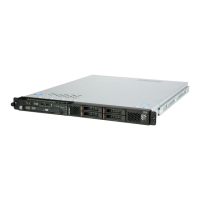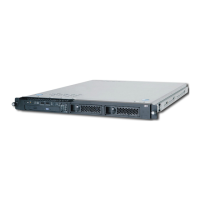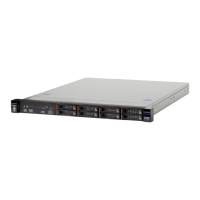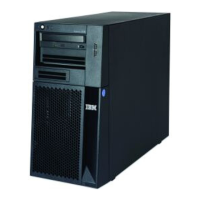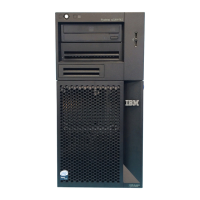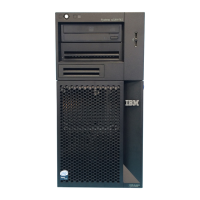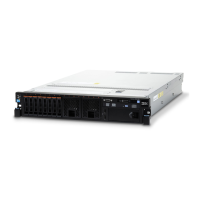v If the server is a simple-swap SATA model and you have installed an optional
SATA RAID Kit, you can use the LSI Logic Configuration Utility program to
configure the simple-swap SATA hard disk drives.
v If you install an optional RAID controller in the server, such as the ServeRAID 8s
controller, use the configuration software that comes with the adapter to configure
the hard disk drives.
Starting the LSI Logic Configuration Utility program
To start the LSI Logic Configuration Utility program, complete the following steps:
1. Turn on the server.
2. When the prompt Press CTRL-C to start LSI Logic Configuration Utility...
is displayed, press Ctrl+C. If you have set an administrator password, you are
prompted to type the password.
3. Use the arrow keys to select the adapter (SAS controller) for which you want to
change settings. Use the Help function to see instructions and available actions
for this screen. If you select SAS Topology or Advanced Adapter Properties,
additional screens are displayed.
4. To change the settings of the selected items, follow the instructions on the
screen.
5. Press Enter to save your changes.
Configuring the controller and devices
You can view and change settings for the following items for the selected adapter
(controller):
Boot Support
Specify the type of boot support that will be in effect (disabled, BIOS only,
OS only, or both BIOS and OS)
RAID Properties
Create a RAID array from the choices that are displayed
SAS Topology
View information about the devices attached to the selected SAS controller.
Format and verify an attached device.
Advanced Adapter Properties
View the SAS properties and change the following items for the selected
adapter:
v Global properties
v Cylinder head sector (CHS) mapping
v Link error settings
v Advanced device properties, such as I/O timeouts and LUNs to scan
v Spinup properties
v PHY properties
Configuring the Ethernet controller
The Ethernet controllers are integrated on the system board. They provide an
interface for connecting to a 10 Mbps, 100 Mbps, or 1 Gbps network and provide
full-duplex (FDX) capability, which enables simultaneous transmission and reception
of data on the network. If the Ethernet ports in the server support auto-negotiation,
the controllers detect the data-transfer rate (10BASE-T, 100BASE-TX, or
1000BASE-T) and duplex mode (full-duplex or half-duplex) of the network and
automatically operate at that rate and mode.
Chapter 2. Configuration information and instructions 13
